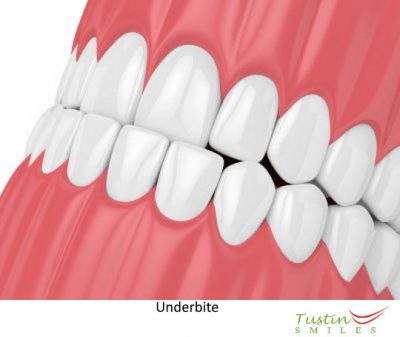A protruding lower jaw is referred to as an underbite in dentistry. As a result, the lower jaw extends beyond the upper teeth. Underbite severity may range from a minor example in which the lower jaw overlaps the upper jaw to a severe case in which the teeth do not connect due to the gap being so large. Know more about invisible aligners.
What Causes an Underbite? | Types of Underbites | What issues does an underbite cause? | How to Treat an Underbite | Overbite Vs Underbite
What Causes an Underbite?
 Your teeth typically develop in such a manner that the top teeth fit over the lower teeth. The molars should be able to fit together. However, various variables contribute to the development of this condition. Listed below are a few of them:
Your teeth typically develop in such a manner that the top teeth fit over the lower teeth. The molars should be able to fit together. However, various variables contribute to the development of this condition. Listed below are a few of them:
Genetics
If you have a family member who also has this ailment, you are more likely to get it. Additionally, genetics determine a person’s jaw form, tooth shape, and size.
As a result, some children are born with teeth that are too close together, impacted, do not grow all of their teeth (hypodontia), are irregularly formed, have an overjet, or have teeth that do not fit together properly.
Childhood Habits
Certain childhood behaviors may have a role in the development of an underbite. These behaviors include the following:
- Use of a pacifier by children over the age of three
- Thumb sucking (can also cause tongue thrust.)
- Nail biting
- Long-term bottle-feeding
- Poor oral hygiene practices (which also causes dental plaque and tooth decay)
Injury
Severe injuries to the jawbones may result in permanent damage. While it is often feasible to restore a fractured jawbone, even after surgical realignment, the jaws frequently do not fit correctly.
Tumors
Tumors in the jawbones or mouth may cause the jaws to protrude, resulting in an underbite.
Types of Underbites
Underbites are classified into two types.
Dental underbites are a misalignment of the teeth that develop when a crossbite arises in the front of the mouth rather than the sides. Although the teeth are somewhat forward, the lower jaw does not protrude.
Skeletal underbites arise as a result of a jawbone deformity. Typically, it is inherited.
See more on transparent brackets.
What Issues Does an Underbite Cause?
An underbite is not only an aesthetic concern. According to the American Dental Association (ADA), the more serious this issue is, the more likely it is to create oral health concerns such as the following:
- Speaking difficulties
- Difficulty chewing
- Pain in the mouth and face as a result of malocclusion.
- Sleep apnea
- Tooth enamel wear that is excessive
- Chronic mouthbreathing and bad breath
- Prognathism
Additionally, when you have a prominent underbite, your confidence will suffer.
How to Treat an Underbite
It is usual for teeth to be somewhat misaligned after the majority of the permanent teeth have undergone tooth eruption. However, in certain circumstances, the underbite is severe enough that treatment results in more substantial advantages for the patient. Clinical medicine cannot treat underbite alone so, allow Tustin Smiles can assist you in resolving your underbite issues.
Below are some of those benefits:
- Your teeth are simple to keep clean.
- Your gums will be healthier as it prevents the risk of periodontitis.
- There will be less tension on the jaws, teeth, and face muscles as a result.
- Reduce the risk of developing a dental abscess.
- It decreases the chance of tooth fracture or tooth loss.
- Reduces the chance of developing a temporomandibular joint disorder
The only method to correct this issue is for a specialist to align it. Correcting this problem need the assistance of an orthodontist. Dr. Amit Shah may correct your underbite with one of the following procedures:
Braces -It is the most often used orthodontic treatment for underbite. Dental braces are not inconspicuous and may be apparent while speaking or smiling. This issue is resolved using clear aligners.
Appliances – Certain appliances are capable of treating this problem. These are custom-made for your mouth and might sometimes be painful because to their greater visibility than braces. When orthodontic therapy is essential, orthodontists suggest it.
The reverse full facemask is an example of an orthodontic device. This item resembles orthodontic headgear that is worn around the head. To correct an underbite with this approach, metal bands are attached to your upper back teeth, allowing the device to gently pull your upper jaw into perfect alignment.
The upper jaw expander is another form of dental device. The upper jaw expander is a screw-in device that fits over the upper jaw’s rear teeth. The objective is to increase the width of the upper jaw, enlarge the dental arch, and reposition the teeth inside the bone. This, however, is dependent on the pathology of the maxilla and mandible.
Tooth Extraction – Extraction of a tooth may alleviate crowding, allowing biting to occur more naturally.
Surgery – This should only be used as a last resort if the orthodontist considers that all other treatment options have failed. This occurs seldom, since surgical surgery of an underbite is sometimes unnecessary.
Orthognathic surgery is a kind of jaw surgery. This form of surgery is very customized and entails splitting your jawbones and making customized adjustments to your jaw alignment.
If you have cleft lip and palate, you may need surgery prior to addressing your underbite. Read about fix chipped tooth and behind the teeth.
Overbite Vs Underbite
When your mouth is closed, an overbite occurs when your upper teeth overlap your lower teeth excessively. This issue is often seen in individuals who have a smaller jaw or whose lower jaw is shorter than their upper jaw. Sometimes, an overgrowth of tissue on the border between your gum line and your two upper front teeth will cause the teeth to push apart, resulting in diastema smile.
When your mouth is closed, an underbite occurs when your lower jaw lies in front of your upper jaw. When you have this issue, you typically have the appearance of a projecting chin, but this may be more muted in less severe instances. Schedule an appointment for consultation with our specialist.
